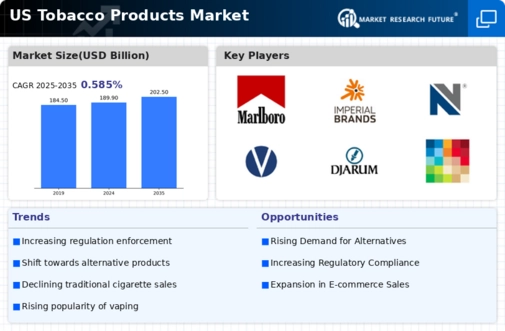The US Tobacco Products Market is characterized by a complex landscape shaped by evolving consumer preferences, regulatory challenges, and significant competition among various players. As the market grapples with increased health awareness and changing demographics, companies are constantly innovating to maintain their foothold. The competitive insights highlight the strong presence of both traditional and emerging brands, each attempting to harness unique strategies to attract consumers while complying with stringent regulations. Throughout this market, key factors such as product diversification, pricing strategies, branding, and distribution channels play pivotal roles in shaping the competitive dynamics.
A thorough understanding of these aspects is crucial for entities looking to navigate the ever-evolving US Tobacco landscape.LIGGETT GROUP has established itself as a notable player in the US Tobacco Products Market, known for its diverse range of offerings. With a focus on providing value-oriented tobacco products, the company emphasizes cost-effectiveness while maintaining quality. This strategy allows LIGGETT GROUP to target price-sensitive consumers effectively, thereby enhancing its market share in a highly competitive environment. Their extensive distribution network ensures that products are readily available across various retail channels, further solidifying their presence in the market.
Additionally, LIGGETT GROUP's adaptability and keen understanding of consumer preferences empower it to introduce innovative products that cater to the shifting demands of the tobacco landscape, positioning the company favorably among its competitors.Marlboro, a flagship brand in the US Tobacco Products Market, has achieved remarkable recognition and loyalty among consumers. Known for its iconic image and extensive product range, Marlboro offers a variety of cigarette lines that cater to different consumer tastes, including lower tar and alternative flavors.
The brand's strength lies in its strategic marketing campaigns that evoke a sense of lifestyle and identity, which resonate well with its target audience. Marlboro's consistent presence in retail and convenience stores across the US ensures robust market visibility. Furthermore, the brand has engaged in various mergers and acquisitions to bolster its portfolio and enhance its operational efficiency, reinforcing its dominant position in the market. With a commitment to innovation and compliance with regulatory standards, Marlboro continues to adapt to market trends while remaining a leader in the competitive landscape of tobacco products.




















